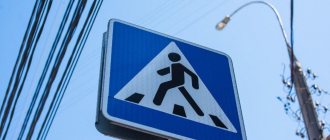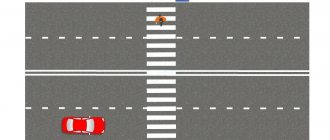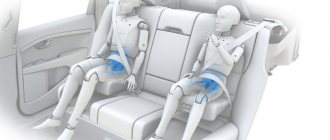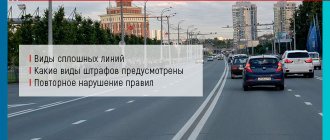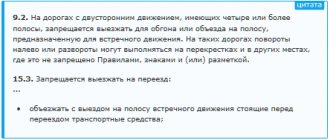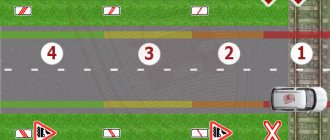- Rules for stopping near a crossing, possible consequences of violation
- Fine for violating parking rules at or near a pedestrian crossing
- In what situations is a motorist not held accountable?
Compliance with traffic rules is the direct responsibility of the motorist. This statement applies both to the process of moving vehicles and to stopping or parking. One of the common violations of the rules is stopping a car at a pedestrian crossing or at an unacceptable distance from it. In such a situation, it is worth knowing what actions are permitted and prohibited, as well as what punishment will await a motorist who violates the established requirements.
Rules for stopping and parking
A pedestrian crossing is a part of a highway designated for pedestrians to safely cross the roadway. For additional convenience, the area is allocated. This is done using:
- Special markings on the road surface in the form of alternating stripes (zebras).
- Installation of road signs “Pedestrian crossing” in addition to markings.
The rules for stopping and parking vehicles are regulated by section 12 of the Traffic Rules. In accordance with it, stopping (stopping the movement of a vehicle for up to 5 minutes) and parking (stopping for more than 5 minutes) in the pedestrian crossing area is prohibited. It is allowed to stop a vehicle no closer than 5 meters before the marking. In its absence, the landmark indicating the boundaries of the pedestrian crossing zone is road signs.
Parking rules in such cases
According to paragraph 4 of Article 12 of the Traffic Rules, a stop near the crossing must be made up to, at a distance of 5 meters. Stopping at a zebra crossing is prohibited.
If there is a zebra marking, then this distance is measured from it. If there is no marking, then it is counted from the iron sign.
If there is a traffic jam behind the pedestrian crossing, then you can stop directly in front of the zebra crossing, leaving space for people to cross the road (clause 4 of article 14 of the traffic rules). When giving way to pedestrians at unregulated pedestrian crossings, you must park in front of the stop line.
Clause 5 of Art. 12 of the traffic rules states that parking is also prohibited at pedestrian crossings and in places closer than 5 meters in front of them.
When is it permissible to stop in a pedestrian crossing area?
In some cases, it is permitted to stop/leave a vehicle in a pedestrian crossing area:
- after crossing the markings (permissible when driving in your own lane);
- immediately before/five meters after a pedestrian crossing on the left side of the road (with two lanes), provided that the vehicle does not block the view of drivers and does not create an obstacle to the movement of pedestrians.
The rules allow a forced stop at a pedestrian crossing or in its immediate vicinity. In this case, the driver must turn off the emergency signal and try again to start the engine. In case of failure, it is necessary to move the car beyond the limits of the “Pedestrian Crossing” sign manually or with the assistance of third parties. Next, you need to act according to the situation: install an emergency stop sign and call repairmen or carry out repair work yourself.
The driver also has the right to stop driving due to poor health. Formally, in this situation, the traffic police officer cannot issue a fine, but at the same time he has the right to offer assistance and call an ambulance. If the offender refuses, the inspector may have doubts about the veracity of his actions and will be regarded as deception.
In what situations is a motorist not held liable?
It may happen that the driver has to stop at some place, including at a pedestrian crossing. For example, if the engine stalls and the driver tries to start the car again. Paragraph 12.6 of the traffic rules allows you to do this during a forced stop.
What is a forced stop?
Let's turn to part 1 of the Rules of the Road. There is a definition of this concept. This is the cessation of vehicle movement for the following reasons:
- the cargo transported on the vehicle creates a danger;
- technical malfunction;
- the occurrence of an obstacle in the direction of travel;
- poor health of the driver or his passenger.
In these cases, first of all, it is necessary to turn on the emergency lights . Only after this can any action be taken. For example, if the car stalled, the procedure would be as follows:
- We turn on the emergency lights.
- We are trying to start the car.
- If it doesn’t start, we roll the car away from the transition zone, put up a sign and take measures to eliminate the problem ourselves or with the help of technical service.
Despite the fact that in such a situation the driver has the right to stop near a pedestrian crossing, it should be understood that the pedestrian always has priority there. Care must be taken to avoid putting him in danger.
Read more about forced stops in our other article.
Fine for stopping at a pedestrian crossing
If a driver, neglecting traffic rules, stops a vehicle at a pedestrian crossing marking, he may be held administratively liable. In this case, Article 12.19 of the Code of Administrative Offenses
.
It provides for punishment in the form of a fine in the amount of 1000 rubles
.
If the violation occurred in a city of federal significance (Moscow, St. Petersburg), the amount of the administrative fine increases to 3,000 rubles
.
Also, the traffic police inspector has the authority to issue a report on the detention of the vehicle with its subsequent evacuation from the scene of the incident. This is done in the case when the driver is not present at the time the violation is recorded.
The very fact of moving the car to the impound lot increases the driver's costs. He is financially responsible for transportation by a tow truck and maintaining the car at the impound site. He undertakes to compensate all costs in accordance with current tariffs. Payment is required. It can be paid after receiving the car along with the amount of the fine.
Controversial situations of this traffic violation and ways to avoid sanctions in such cases
With this type of offense, many controversial situations do not arise. This is due to the fact that the offense is committed in a static state. If illegal overtaking or driving through a red traffic light occurs while moving, and it is more difficult to detect them, then stopping at a pedestrian crossing involves immobilizing the car for some time, and the defender of the law has more time to observe the violator.
But there are still situations when one can argue when a stop without observing 5 meters was made in connection with:
- technical problem with the car;
- the danger that the transported cargo may create;
- poor health of the driver;
- obstacle on the roadway.
If you are right, never rush to sign the protocol and agree with what is written in it; first, try to explain to the traffic police officer the reasons for the stop. Request from the inspector a video recording that shows the fact that you violated legal requirements.
If the case reaches the court, which makes a decision not in your favor, you can appeal it within ten days. This will give you another chance to prove you are right.
The court will definitely side with you, if you prove that you had an unexpected breakdown and you stalled, turned on the emergency lights and took all measures to remove the car from the roadway so as not to interfere with traffic, the court will definitely side with you.
How to appeal a penalty
The driver has the right to appeal the imposition of a fine in a number of cases:
- facts confirming the unlawful action of traffic inspectors;
- errors and inaccuracies in the protocol that contradict the real situation;
- documentary data confirming the driver’s absence of guilt (photos, videos, witness statements).
The complaint must be drawn up and filed within 10 days after drawing up the incident report. It is sent to the head of the regional traffic police department or to the court at the place of residence (registration). If a citizen missed this deadline, he also has the right to file a petition to restore the deadline for filing an appeal. In controversial situations, professional legal support may be required.
How can the traffic police prove your guilt?
Traffic police officers can prove the commission of this offense in the following cases:
- if this happened in front of the traffic police officer himself;
- if this can be confirmed by other witnesses;
- if it is recorded on video, and this could be a DVR, private external surveillance cameras, traffic police service cameras.
It is impossible to imagine driving a car without stopping, parking and parking. It is important to know the rules for performing these actions, especially near pedestrian crossings.
The coverage area of the “Pedestrian Crossing” sign and how to calculate the distance of 5 meters
To stop the car in accordance with the Traffic Rules, you should follow the markings 1.14.1 and 1.14.2:
- 5 m before the line of pedestrians (after the marking line, this distance does not have to be observed when parking);
- If the markings are located near an intersection, you should brake 5 m before it.
If you stop closer than 5 m before the crossing, the view of other drivers is blocked, which can lead to a careless maneuver and danger for pedestrians. That is why it is important to correctly calculate how many meters will remain between the car and the markings.
In addition to calculating how many meters are left to the pedestrian zone, you need to make sure that there is no road sign 3.27, which prohibits parking regardless of the distance to the pedestrian area.
To correctly calculate how many meters you need to park, you should focus on markings 1.14.1 and 1.14.2 or signs 5.19.1 and 5.19.2, which are installed on both sides of the pedestrian intersection.
Not everyone can determine by eye at what distance from the zebra the car should be stopped, so it is recommended to adhere to the rule: the greater the distance, the better. After all, if an employee of the State Traffic Inspectorate has doubts, he will make accurate measurements, and if the parking distance is less than 5 m to the markings, a fine will be issued.
Near the pedestrian line, you must also be aware of the braking of other vehicles if there are several lanes on the road. If an unscrupulous driver violates the established rules, you should not stop next to him.
Responsibility
Responsibility for stopping in the wrong place, including at a pedestrian crossing, is provided for in Art. 12.19. Code of Administrative Offences. According to this norm, violators face a fine of 1,000 rubles, as well as evacuation of the vehicle to an impound lot . If the offense occurred in cities such as Moscow or St. Petersburg, then you will have to pay 3,000 rubles.
Due to the large number of appeals to the courts regarding the evacuation of vehicles in front of the violators, when they were already ready to correct their mistake, Federal Law No. 143 of 06/08/2015 was adopted, which introduced an additional part 1.1 to Article 27.13 of the Code of Administrative Offences.
According to the rules established there, if at the time the vehicle is detained the owner of the car or any person who can drive it appears, then the evacuation is stopped . Under one condition - the carrier has not yet moved.
The person requesting the return of the car will have to pay the price of moving it and storing it in the parking lot. Prices will differ by region, since it is the executive authorities of the subject that set tariffs based on methodological recommendations approved by FAS Order No. 1145/16 dated August 15, 2016. Therefore, when parking in front of a zebra crossing, pay attention to how many meters your car is before it.
According to the rules of paragraph 10 of Art. 27.13 of the Code of Administrative Offenses , the car must be returned immediately after the reason for its seizure has been eliminated . But the same norm gives powers to the authorities of the constituent entities to establish separate rules for evacuation and storage.
Thus, in some regions, you can pick up the car and then pay all the amounts specified in the protocol, and in some, there are additional conditions. For example, if a car has been parked in an impound lot for more than a day, then in some areas you must first pay for such services and then hit the road.
Drawing up a protocol
As a rule, evacuation of a car from a pedestrian crossing occurs when the driver is absent. Otherwise, as mentioned above, it could have been stopped. In the absence of the owner, a car report is drawn up in front of two witnesses or when the event is recorded on a video camera . The document must reflect: date, time, place, reasons for which the seizure occurred, data of the official who compiled the document, information of the vehicle.
But even if you showed up on time and no evacuation occurred, you will have to pay a fine for parking in front of a pedestrian crossing. A protocol is also drawn up about this fact, containing the same information, but it also indicates the details of the violator.
If you do not agree with the protocol, you can appeal it . The complaint is submitted either to a higher official, then the time for its consideration is 10 days, or directly to the court, where it will be resolved within 2 months. Read about how to write a complaint against a resolution drawn up by a traffic police officer in this article.
The fine will need to be paid within 60 days. But if you fulfill the obligation in the first 20 days, you will receive a nice bonus - a 50% discount.
How to Avoid Responsibility
You can avoid liability only in three cases:
- You made a forced stop and took all necessary actions to minimize your violation.
- The stop was made to board a passenger or place cargo , provided that it took less than 5 minutes.
- You have parked after a pedestrian crossing.
Of course, no one will stand with a stopwatch, accurately calculating the time, but if your car has been sitting there for half a day, with the engine turned off, and you are not driving, then obviously there is no question of being able to prove your innocence.
conclusions
The only option that exempts the driver from punishment is a forced stop. Therefore, it is necessary to avoid any violations, even if there is no traffic police inspector nearby. Any passerby can take a photo and send it to the relevant authorities. If an unforeseen situation occurs with a subsequent stop, then you need to take measures as quickly as possible to move the vehicle to the permitted area. If this is not possible, the driver is required to use the hazard warning lights as in case of an accident. Additionally, an emergency parking sign must be installed at a distance of more than 15 meters from the vehicle.
How to stop correctly
A stop, unlike a parking lot, is a short-term fixation, no more than 5 minutes. To secure a stationary vehicle, you need to choose areas that are safe for other participants. In some particularly crowded places, maximum attention is required. Hitting a zebra crossing is prohibited. You should carefully monitor the presence of the corresponding sign.
A prohibition on stopping in a certain road zone is indicated by a sign prohibiting stopping a car in place.
Parking is considered acceptable if:
- no hitting a zebra crossing;
- the distance with the sign is maintained - 5 meters.
How to determine the acceptable interval before a transition
If there is a pointer, it will become the starting point for counting 5 meters. If there is no prohibiting sign, the driver must control the crossing distance on the road independently. Then the countdown is made from the extreme marking point on the road surface.
If it is allowed on a certain section of the road, in particular at a stop, this does not mean that parking is allowed. If you leave your car here, you risk getting a fine + having your car towed.
When there is a violation
If the distance with the sign in the decreasing direction is not observed, the driver faces a fine. It can be avoided if stopping in the wrong place was unintentional. Then a protocol is drawn up and the car is taken to the impound lot.
When a driver stops in a pedestrian zone to avoid hitting a passenger, colliding with another vehicle, or due to a breakdown, this is not a traffic violation. There is no fine for a forced stop.
By paying off fines for traffic violations within 20 days from the date of the determination, you can receive a 50% discount. The total payment period is up to 60 days.
When there is no violation
A driver can stop a car near a zebra crossing at a distance of 5 meters. This is necessary so that when the vehicle is fixed, visibility for other participants does not deteriorate. You cannot cover the markings and the pedestrians themselves.
A vehicle (up to 3.5 tons) can stop for the purpose of unloading from the left side of a two-way lane when moving in one direction.
If the driver did not intend to break the rules, but was forced to do so due to a breakdown of the vehicle and other circumstances, then this will not be classified as a violation. In this case, no protocol is drawn up and no evacuation is carried out.
If the flow of pedestrians does not allow the driver to complete the maneuver while the green light turns on, the driver is forced to slow down at the zebra crossing. Such a stop is a necessary measure to prevent a collision with a person. It is necessary to complete the maneuver, since parking at a zebra crossing is a serious violation.
If the car breaks down, the alarm signal immediately turns on. An emergency sign must be placed. When the car cannot be started, it must be manually rolled to a safe distance. You can call technical assistance to transport the vehicle to a car service center.
What do lawyers advise?
The Code of Administrative Offenses states verbatim that stopping at markings intended for pedestrians is only possible if forced. If your car accidentally stalls at a zebra crossing, you need to turn on the hazard lights and try to start the car.
In the event that a serious breakdown occurs, experts advise adhering to the following algorithm of actions:
- We manually try to roll the vehicle away from the coverage area of the marking signs.
- We put up an emergency stop sign.
- We turn on the emergency alarm.
- We call for help.
- If possible, we try to revive the car ourselves.
Remember that at a zebra crossing, priority always goes to the person crossing the roadway. Follow traffic rules, be careful and you will not have to replenish the state treasury with your personal funds. Good luck!
Is it possible to stop by turning on the emergency lights?
An emergency stop signal, of course, is a sign of a forced stop, but this is a necessary, but not a sufficient condition. You won't be able to avoid a fine for stopping at a crossing only with the help of an emergency light. To prevent the inspector from issuing a fine, the driver will also have to place a warning triangle behind his car. Such a sign will attract the attention of other drivers and force them to slow down - this will significantly reduce the likelihood of hitting a pedestrian. If a stopped motorist turns on only the emergency lights, he will have to prove the necessity of such a stop himself after the protocol on the administrative offense has been drawn up.
Features of parking at a pedestrian crossing
Parking involves stopping or leaving the car on the roadway or in other designated areas. The duration of downtime does not matter. If the driver turns off the engine, it means he has parked.
Traffic regulations prohibit drivers from parking their cars directly on the zebra crossing. This is indicated in paragraph 12.4 of the traffic rules. This zone is intended for pedestrians to cross the road, and the car will simply interfere with their movement. Therefore, motorists try to drive a considerable distance away from the zebra crossing. But is it possible to park near a zebra crossing? Not every motorist knows the answer to this question.
Traffic rules do not prohibit drivers from leaving their cars near a pedestrian crossing. However, a number of nuances must be taken into account. Let's look at them in more detail:
- Before stopping the car, the driver must make sure that he does not violate the parking rules.
- It is important to observe the footage from the zebra to the vehicle established by the current legislation. There must be a distance of at least five meters between the pedestrian crossing and the car.
- The motorist must make sure that his car does not interfere with the passage of other vehicles, and that traffic regulations are met.
In case of violation of traffic rules, the driver will be held criminally liable. In addition to the Code of Administrative Offenses of the Russian Federation, when determining punishment, local laws established by municipal authorities may be taken into account.
Can a car be towed?
Stopping at the markings is strictly prohibited. Traffic police officers are even more strict towards a car owner who parked his car in the pedestrian crossing area and next to it and left the vehicle. In this case, the State Traffic Inspectorate measures how many meters separate the car and the markings, and then has every right to evacuate the car to the impound lot without notifying the car owner in advance.
If a person does not find his car in the parking area in the crossing area, he should contact the traffic police duty department, where he will be provided with all the necessary information.
In addition to the parking fine, the violator is required to pay for the operation of the tow truck, as well as services for maintaining the car in a special parking lot. Only after this the car owner will have access to his vehicle.
Stopping before crossing roadways
If there is no stop line at the intersection, then you must stop the car before crossing the roadways:
I would like to note that the rules require stopping before the intersection only in the two cases discussed above:
- Controlled intersection. Movement is prohibited by a traffic light or traffic controller.
- An unregulated unequal intersection with sign 2.5 “Moving without stopping is prohibited.”
In all other cases, stopping is not necessary.
Payment of the penalty
When a penalty is imposed, payment of the fine must be made as quickly as possible. There are several acceptable options, which are specified in Art. 32.2 Code of Administrative Offences. Basically, a fine for parking at a pedestrian crossing is paid:
- in any bank according to the details specified in the resolution;
- through online services, such as the State portal, Yandex.Fines, etc.
Important! When paying within a 20-day period from the date the Resolution enters into legal force, you can take advantage of a 50% discount on the assigned amount.
If the grace period is missed, the fine is paid in full. The standard period for payment is 60 days, then penalties begin to accrue.
